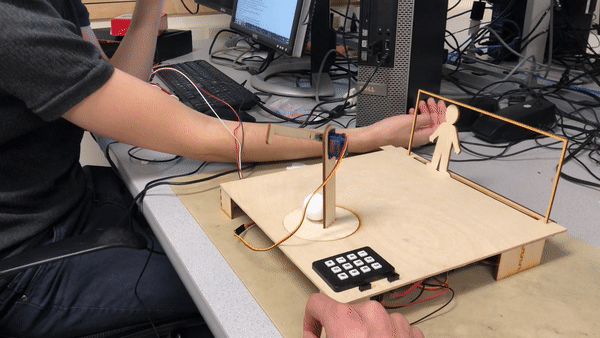Two animated GIFs of our game in action are shown below. The animation on the left shows our game running at its lowest difficulty setting while the animation on the right shows the game running on its highest difficulty setting.

Lowest Difficulty Setting

Highest Difficulty Setting
Our game's execution speed is limited by the specification of the servos it uses. Because these servos require a 50Hz control signal, our system is incapable of making adjustments more than once every 20 ms.
Our game's average input delay is 30 ms, with a maximum input delay of 40 ms and a minimum input delay of 20 ms. The primary cause of this input delay is the noise reduction technique we employ in detecting when a player intends to trigger a kick. Because we require the player input signal to be above a threshold for two iterations of the servo control thread, these delays are each 20 ms (i.e., the duration of 1 iteration of this control thread) longer than their minimum theoretical value. However, we found that an additional 20 ms of input lag was well worth the added stability provided by this debouncing technique.
Safety was one of our primary concerns in the design of this project. Before starting the project, we were warned about the dangers associated with connecting bodily sensors to the electrical grid. If a ground loop is established between such a sensor and the grid, the person wearing the sensor runs a serious risk of being electrocuted. This warning is confirmed by the datasheet for the EMG muscle sensor used in this project, as shown in the screencaps below:


Screencaps from EMG Muscle Sensor Datasheet
As such, our final implementation is intended to be operated entirely off of battery power, so that the muscle sensor is never connected to the electrical grid. Even while testing, we were extremely careful to never connect any part of the system connected to the muscle sensor to the grid.
Our system does not use RF transmission, and as such we do not expect it to cause interference issues with other devices or systems.
Our game is simple to understand and should be able to be picked up rather easily by a potential user. The game does currently require the use of an EMG muscle sensor as a controller. Consequently, those with limited mobility or motor control may have issues attaching and/or operating this sensor. However, it is not too difficult to rework our system to accept input from a pushbutton instead of this sensor in order to assist those who have difficulty using the muscle sensor.



